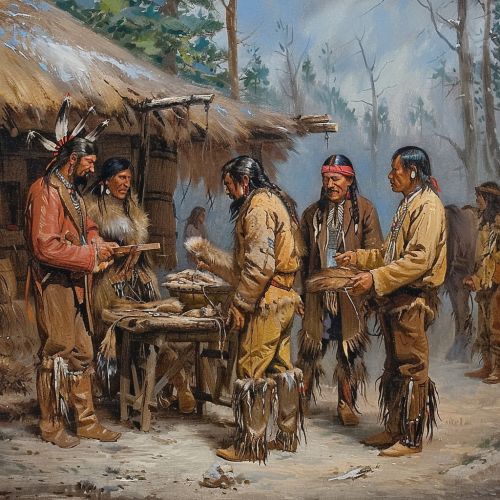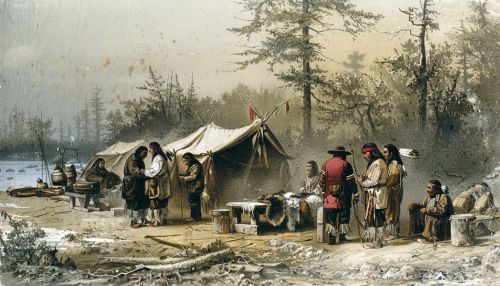Fur trade
History of the Fur Trade
The fur trade has been a significant economic activity for centuries, particularly in North America, Europe, and Asia. It involves the exchange of animal pelts for goods or currency. This trade played a crucial role in the exploration and colonization of the New World, influencing the economic and social development of various regions.
Early Beginnings
The fur trade can be traced back to ancient times when indigenous peoples of North America, Europe, and Asia traded animal pelts for essential goods. In Europe, the demand for fur grew during the Middle Ages, driven by the need for warm clothing and the status symbol associated with fur garments. The Vikings were among the earliest European traders, exchanging furs with other cultures.
European Colonization and Expansion
The fur trade became more organized and extensive with the arrival of European explorers in North America. The French, English, and Dutch established trading posts and formed alliances with Native American tribes. The Hudson's Bay Company, founded in 1670, and the North West Company were two of the most prominent fur trading enterprises. These companies competed fiercely for control over the fur trade routes and territories.


Economic Impact
The fur trade significantly influenced the economies of the regions involved. It provided a source of income for indigenous peoples and European settlers, facilitated the exchange of goods, and contributed to the development of infrastructure.
Indigenous Economies
For many Native American tribes, the fur trade became a vital part of their economies. They hunted animals such as beavers, otters, and foxes, and traded the pelts for European goods like metal tools, firearms, and textiles. This exchange had both positive and negative impacts on indigenous communities, altering their traditional ways of life and sometimes leading to overhunting and resource depletion.
European Economies
In Europe, the fur trade contributed to the growth of industries related to fur processing and garment manufacturing. Cities like London and Paris became centers for the fur trade, with merchants and craftsmen specializing in the production of fur clothing and accessories. The wealth generated from the fur trade also financed further exploration and colonization efforts.
Social and Cultural Implications
The fur trade had profound social and cultural implications for both indigenous peoples and European settlers. It fostered interactions and exchanges between different cultures, but also led to conflicts and power struggles.
Cultural Exchange
The fur trade facilitated cultural exchange between Native Americans and Europeans. Indigenous peoples adopted European goods and technologies, while Europeans learned about native customs, languages, and survival skills. This exchange often resulted in the blending of cultures, seen in the creation of Métis communities in Canada, where people of mixed indigenous and European ancestry emerged.
Conflicts and Alliances
The competition for control over the fur trade led to conflicts among European powers and between Europeans and Native American tribes. Alliances were formed and broken, with tribes often aligning with one European power against another. The Beaver Wars in the 17th century, for example, were a series of conflicts between the Iroquois Confederacy and other Native American tribes, influenced by the fur trade dynamics.
Environmental Impact
The fur trade had significant environmental consequences, particularly in North America. The demand for fur led to extensive hunting and trapping, which affected animal populations and ecosystems.
Overhunting
Beavers, in particular, were heavily hunted for their valuable pelts. The depletion of beaver populations had cascading effects on the environment, as beavers play a crucial role in maintaining wetland ecosystems. Overhunting also impacted other fur-bearing animals, leading to a decline in biodiversity.
Habitat Alteration
The establishment of trading posts and settlements often resulted in habitat alteration and deforestation. The construction of infrastructure to support the fur trade, such as roads and forts, disrupted natural landscapes and contributed to environmental degradation.
Decline and Legacy
The fur trade began to decline in the 19th century due to various factors, including changes in fashion, the depletion of fur-bearing animal populations, and the rise of alternative industries.
Changing Fashion Trends
By the mid-19th century, the demand for fur garments decreased as fashion trends shifted towards other materials. The development of synthetic fabrics and the rise of the textile industry also contributed to the decline of the fur trade.
Conservation Efforts
The decline of the fur trade led to increased awareness of the need for wildlife conservation. Efforts to protect fur-bearing animals and their habitats emerged, resulting in the establishment of national parks and wildlife reserves. Organizations like the World Wildlife Fund advocate for the conservation of species that were once heavily hunted for their fur.
